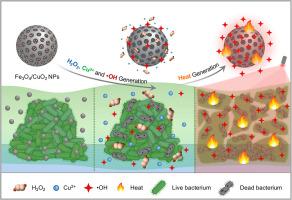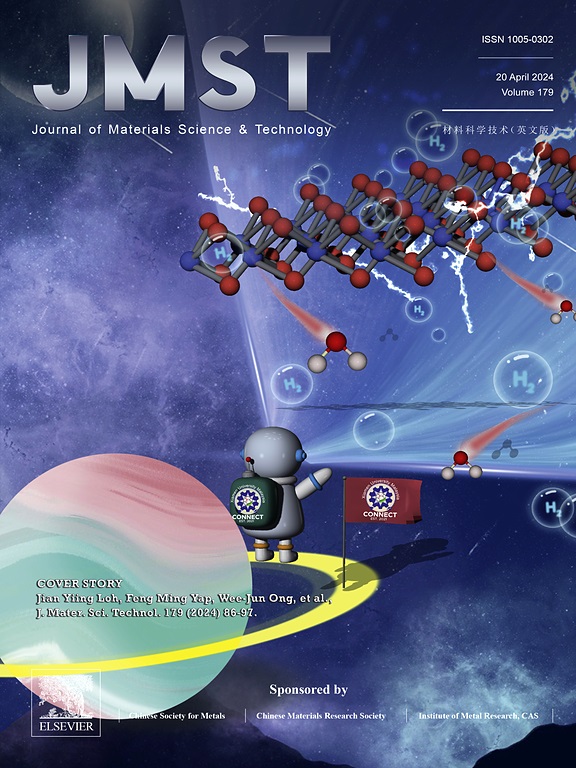生物膜清除的强化化学动力疗法:具有集成光热特性的自供应H2O2纳米平台
IF 11.2
1区 材料科学
Q1 MATERIALS SCIENCE, MULTIDISCIPLINARY
引用次数: 0
摘要
细菌生物膜感染具有高死亡率和难以恢复的特点,对全球健康构成重大风险。开发创新的抗菌材料和疗法,特别是那些减轻耐药性的材料和疗法,对于有效解决生物膜相关感染至关重要。化学动力疗法(CDT)依靠过氧化氢(H2O2)产生的羟基自由基(·OH)来消灭细菌,已被证明在治疗浮游生物感染方面具有潜力。然而,由于内源性H2O2和生物膜内保护性的细胞外聚合物基质有限,传统CDT对生物膜相关感染的效果较差。本研究设计了一种基于具有自供H2O2能力的CuO2和具有光热性质的Fe3O4的复合纳米平台,以提高CDT根除生物膜的效果。采用原位生长技术,将CuO2掺入中空介孔Fe3O4中,合成了Fe3O4/CuO2复合纳米颗粒(FC NPs)。在弱酸性生物膜微环境中,CuO2分解释放Cu2+和H2O2。Cu2+随后催化释放的H2O2类芬顿转化为·OH。同时,Fe3O4的近红外(NIR)照射产生显著的热量,促进了·OH的产生,增加了细菌膜的通透性,从而增强了细菌对·OH的脆弱性。该纳米平台显示出显著的CDT效果,在体外近红外照射5分钟内,可根除99.99%以上的耐甲氧西林金黄色葡萄球菌(MRSA)和99.97%的铜绿假单胞菌生物膜。此外,体内实验验证了纳米平台消除生物膜和促进mrsa感染伤口愈合的能力,而不会产生不良反应。这种H2O2自供和热增强方法为克服CDT在生物膜相关感染治疗中的局限性提供了一种有希望的策略。本文章由计算机程序翻译,如有差异,请以英文原文为准。

Enhanced chemodynamic therapy for biofilm eradication: A self-supplied H2O2 nanoplatform with integrated photothermal property
Bacterial biofilm infections, characterized by high mortality and challenging recovery, pose a significant global health risk. Developing innovative antibacterial materials and therapies, particularly those that mitigate resistance, is essential for effectively addressing biofilm-associated infections. Chemical dynamic therapy (CDT), which relies on hydroxyl radicals (·OH) generated from hydrogen peroxide (H2O2) to eliminate bacteria, has demonstrated potential in treating planktonic infections. However, traditional CDT is less effective against biofilm-related infections due to limited endogenous H2O2 and the protective extracellular polymeric matrix within biofilms. In this study, a composite nanoplatform based on CuO2 with self-supplying H2O2 capabilities and Fe3O4 with photothermal properties was designed to improve CDT efficacy for biofilm eradication. The Fe3O4/CuO2 composite nanoparticles (FC NPs) were synthesized by incorporating CuO2 into hollow mesoporous Fe3O4 using an in-situ growth technique. Within the mildly acidic biofilm microenvironment, CuO2 decomposes to release Cu2+ and H2O2. The Cu2+ subsequently catalyzes the Fenton-like conversion of the released H2O2 into ·OH. Concurrently, near-infrared (NIR) irradiation of Fe3O4 generates significant heat, boosting ·OH production and increasing bacterial membrane permeability, thereby enhancing bacterial vulnerability to ·OH. This nanoplatform demonstrated remarkable CDT efficacy, eradicating over 99.99% of methicillin-resistant Staphylococcus aureus (MRSA) and 99.97% of Pseudomonas aeruginosa biofilms within five minutes of NIR irradiation in vitro. Furthermore, in vivo experiments validated the nanoplatform's ability to eradicate biofilms and facilitate the healing of MRSA-infected wounds without adverse effects. This H2O2 self-supplying and heat-enhancing approach presents a promising strategy to overcome the limitations of CDT in biofilm-related infection treatment.
求助全文
通过发布文献求助,成功后即可免费获取论文全文。
去求助
来源期刊

Journal of Materials Science & Technology
工程技术-材料科学:综合
CiteScore
20.00
自引率
11.00%
发文量
995
审稿时长
13 days
期刊介绍:
Journal of Materials Science & Technology strives to promote global collaboration in the field of materials science and technology. It primarily publishes original research papers, invited review articles, letters, research notes, and summaries of scientific achievements. The journal covers a wide range of materials science and technology topics, including metallic materials, inorganic nonmetallic materials, and composite materials.
 求助内容:
求助内容: 应助结果提醒方式:
应助结果提醒方式:


